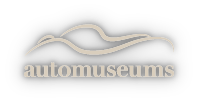Drive Fast, Take Chances: Birth of the Hot Rod exhibit to open at California Automobile Museum
-The California Automobile Museum's newest exhibit will feature cars that were created in California but have been celebrated in movies, songs and popular culture across the country and around the world for a half-century.
The exhibit, Drive Fast, Take Chances: Birth of the Hot Rod is sponsored by So-Cal Speed Shop, Sacramento and runs April 10 through July 5. It explores the hot rod culture that grew out of the dry lakebeds of California in the post-World War II years and ultimately spread to drag strips and back roads, as well as burger drive-ins and street cruises, such as the annual car cruise hosted by the California Automobile Museum which will commence on the streets of Downtown Sacramento on July 31st.
"By definition, every hot rod is a unique expression of style or the owner's desire for speed," said Karen McClaflin, Executive Director of the California Automobile Museum. "But collectively, hot rods represent a common language of individuality and adventure that brings out a bit of rebel or free spirit in each of us."
The idea of hot rods started in the early 1920s and '30s, as racers looking for more speed modified and hopped up Henry Ford's Model Ts and As to find extra horsepower. But the phenomenon exploded after World War II as servicemen returned home and applied what they had learned about mechanics and technology in the military to the cars they were driving.
After the deprivation and hardship of the war years, hot rods were a way of expressing the pent-up demand for adventure and daring, and a way for racers to earn bragging rights for those who could push technology and speed to the limit.
The powerful V-8 engines of Ford, Chevrolet and Chrysler provided more horsepower than the more primitive four-banger engines of the past. The popularity of hot rods created a new, California-centered industry as manufacturers, many of which continue to thrive on world-wide sales today, made crankshafts, pistons, cylinder heads and add-on parts to boost power and speed to record levels.
The first stages on which to push these speed machines to their limit were the dry lakebeds of Southern California, where unofficial "timing contests" were as disorganized as an Oklahoma land rush and twice as dangerous. That same daring was carried out on back roads all over America as the hot rod culture spread from coast to coast.
One of the most prominent of the first cars selected for the exhibit is a legendary "belly tank." It is one of the first examples of a new style of speedster built from army surplus that used aircraft fuel tanks for bodies to take advantage of their minimal wind resistance for maximum speed.
The exhibit will include examples of the style known as "highboys," which mount narrower '28 and '29 bodies for streamlining on a wider '32 Ford frame, which provided more stability at high speed and more room for a V-8 engine, as well as for superchargers and other add-on high performance parts.
The exhibit will also include '32 Ford "Deuce Coupes," still the most popular model among hot rodders, each with a slightly different style illustrating the evolution of speed technology.
For enthusiasts interested in an up-close and detailed "how to" look at hot rod construction, the exhibit will also include a partially disassembled '34 Ford to show off the modifications that are more than skin deep.
This exhibit will be on display through July 5.
Further information
<li><A HREF="http://www.CalAutoMuseum.org">Official site</A></li>
<li><A HREF="/node/136/">Entry in directory</A></li>
